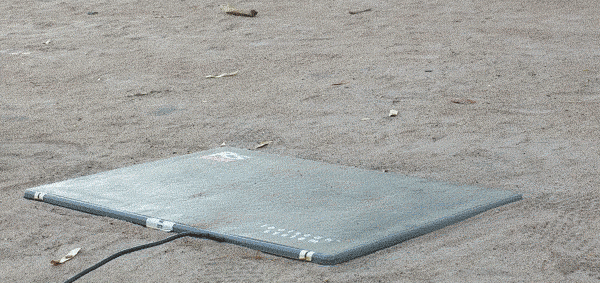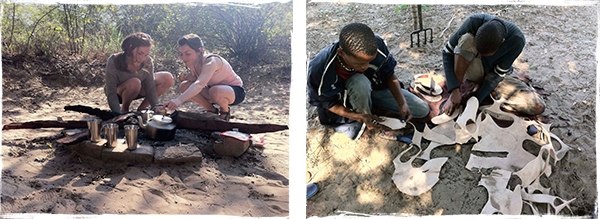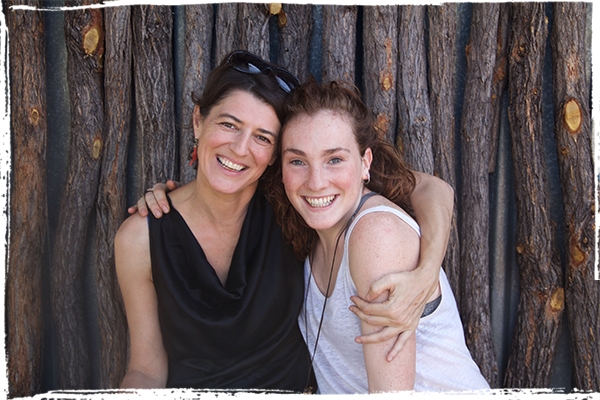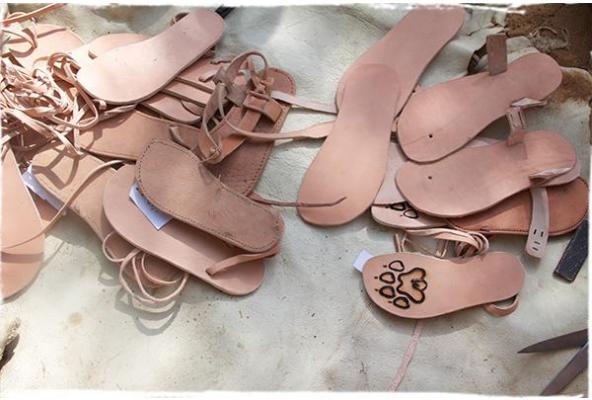Reflections, October 2015. By Catherine Willems.
I am in Namibia. The thermometer indicates 32 degrees Celsius. This is my first time in Southern Africa. The purpose of my visit is to remake the indigenous hunting sandal with the Ju’/hoan San of Nyae Nyae in Namibia, near the border of Botswana. At the same time I will investigate the impact of the leather sandal on gait.
The biomechanics of movement; example of the pressure plate set up.


Walking and running is crucial for humans. We have uniquely evolved as barefoot walkers. Only relatively recently in our history, ca. 25,000 years ago, humans started to wear footwear. During most of that time the footwear remained very basic and was made from plant fibres and/or vegetable tanned leather. The daily use of constricting footwear, with features such as a heel cup, arch support, cushioning and motion control is a recent phenomenon. The Ju’/hoan San use a sandal made out entirely of eland skin with no heel cup, no cushioning, and no arch support and made out of just one material. The San people have been wearing this non-restrictive sandal for thousands of years. In the pictures you see a subject walking barefoot and shod over a plantar pressure plate. For more background on this study have a look at, www.futurefootwear.org
After being picked up at the airport we drive to Windhoek, the capital of Namibia. We passed zebras walking freely on the vast terrains that spread out in front of us. Some strolled along the highway. The next few days we drove North to Tsumkwe and the San villages. I enjoyed the beauty of the seemingly endless plains and experiencing the Namibian countryside with the heat haze rising from the hot sands. More importantly, I had the chance to work with eight artisans, who explained to me how they make their indigenous hunting sandal. In addition to functioning perfectly with the foot, the sandals protect your feet from thorns and the hot sand. As we sat on the ground, on an eland skin, we worked together to make the sandal more suitable for city environments. We decided to add an outsole and place the knots of the laces more flatly. Above all, we wanted to avoid toxic glues, and for that reason we opted for a stitch that connects the insole to the outsole. With these, and other simple design interventions, we made the sandal suitable for urban wear.
MAKING THE FIRST ROUND OF SANDALS


Prior to making the sandal suitable for city environments Flora and Sofie, design students of KASK, School of Arts Gent, Belgium collaborated with the San to re-make their indigenous sandals. Only a few San still know how to make the eland skin sandals, and they shared their ancient shoemaking knowledge and skills with the students. These days the San often make sandals of tire rubber, because they do not have sufficient skins to make them in the original way. Vivobarefoot provided vegetable tanned eland skins and for two weeks Flora and Sofie, the design students, worked and lived in the Kalahari desert with the Ju’/hoansi to re-create leather sandals.
Through transparency, willingness to collaborate, and respectful interaction – we were able to use the San’s knowledge to make the design collaboration a success. I see the sandal as part of their traditional cultural expression, and it was a great pleasure to be involved in this collaboration. This project is about telling two positive stories, one about bringing back a more healthy movement and gait to the Western world, and another about safeguarding the skills of local artisans in times of increasing globalization.
- Catherine Willems, PhD (KASK, School of Arts Gent, Hogent, Belgium)
- Flora Blommaert, master student fashion (KASK, School of Arts Gent, Hogent, Belgium)
www.futurefootwear.org



